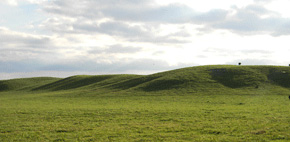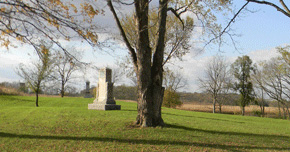TARLTON, THE GH ROAD
THE PICKAWAY PLAINS
AND LOGAN ELM
An excursion south of Circleville along US 23 leads to a group of distinctive rolling hills of great fertility, which once formed a natural open prairie several miles across. In the 1600s, people from the Shawnee and other tribes, driven westward by settlement, began to establish villages and farms here.
Despite early decrees that no settlers could live west of the Appalachians, new colonists kept arriving and clashing with the Indians. It was at a peace conference here that the Shawnee agreed to give up their lands east and south of the Ohio River – the first concession of land by Indians actually living in the Ohio country.
A small, tranquil park (five miles south of Circleville and one mile east of US 23 on SR 361) honors Chief Logan, and his world-famous speech on Indian / White relations. Logan was born a Cayuga in Pennsylvania, where he grew up with many white friends. In 1770, he married a Shawnee woman and moved to the Ohio Country, to live among the Mingo – a group originally from Iroquois roots, like himself. He urged peace with settlers until some of them attacked his village, killing his mother and sister.
Then Logan led the Mingo on raids of revenge against the whites, prompting Lord Dunmore of Virginia to bring an army westward against the Indians. After a battle at Point Pleasant (in today’s West Virginia), the other Indian leaders finally sued for peace, in 1775.

The distinctive rolling prairie lands of the Pickaway Plains remain one of Ohio’s richest agricultural regions.
That peace council was held here, on the vast and fertile “Pickaway Plains.” Logan refused to attend, but sent a speech to be read, expressing his feelings of betrayal and despair. His eloquent words were spoken under a great elm tree here:
I appeal to any white man to say that he ever entered Logan’s cabin, but I gave him meat; that he ever came naked, but I clothed him... He will not turn his heel to save his life. Who is there to mourn for Logan? No one.
The great elm survived until the 1960s, when it was replaced.

The words of “Logan’s Lament” are inscribed on a monument near the newly-replanted “Logan Elm” tree.


